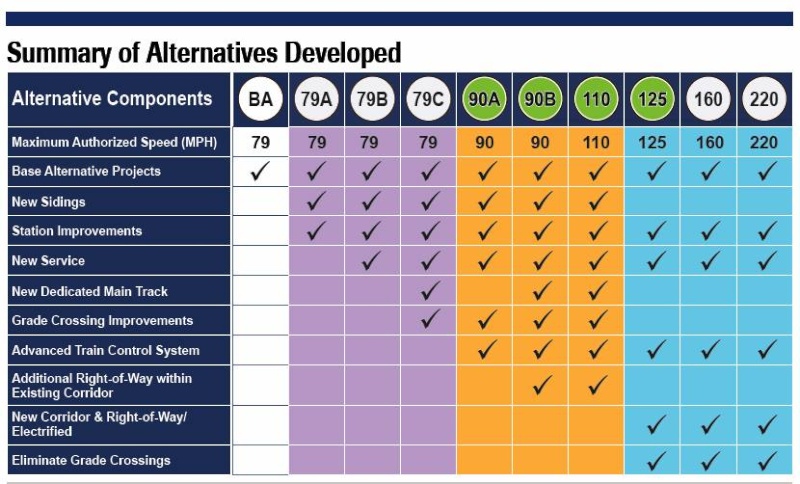jerichowhiskey
Service Attendant
Surprised this has not been posted yet. You can find details of the alternatives NYDOT is considering in this PDF with the full report available at their website. A schedule for public hearings across NY is available and a contact option as well to give comments if you cannot make it to a meeting.

Basic rundown, the alternatives they are offering are to do nothing, option 90A which would lead to track improvements to existing CSX track and add some dedicated passenger tracks for 90MPH service, and options 90B and 110 which would install a dedicated third passenger track with a fourth track at various locations. The 125 MPH option which is to create an entire new right of way with two dedicated electrified tracks is considered too expensive and wouldn't be available until 2035 at the earliest. In terms of cost recovery, 110 option was considered the best and is what the Empire State Passengers Association is supporting.
Times Union

Basic rundown, the alternatives they are offering are to do nothing, option 90A which would lead to track improvements to existing CSX track and add some dedicated passenger tracks for 90MPH service, and options 90B and 110 which would install a dedicated third passenger track with a fourth track at various locations. The 125 MPH option which is to create an entire new right of way with two dedicated electrified tracks is considered too expensive and wouldn't be available until 2035 at the earliest. In terms of cost recovery, 110 option was considered the best and is what the Empire State Passengers Association is supporting.
Times Union
Most of the attention is focused on the corridor west of the Capital Region, where freight traffic is far heavier and Amtrak trains are limited to speeds of 79 mph or less.
The costliest of the remaining four alternatives is a plan that would boost top speeds to 125 mph, construct a new rail line between the Capital Region and Buffalo, and carry a price tag of $14.71 billion.
None of this will happen quickly. Construction on the 125 mph alternative would take until 2035 to complete.
Two alternatives would have trains travel at top speeds of 90 mph, 11 mph faster than the current top speed, and a fourth alternative would boost top speeds to 110 mph.
The study itself is somewhat dated. There are references to air service between Albany and LaGuardia and Kennedy airports in New York City, something that hasn't existed in more than a year, but no reference to the oil trains that are boosting freight movements on area rail lines.
A public hearing will be held March 4 at the Albany Nanotech complex, 257 Fuller Road in Albany. An open house runs from 4 to 8 p.m., with the public hearing from 6 to 8 p.m.
Other hearings will be held March 5 in Syracuse, March 6 in Buffalo, March 7 in Rochester, March 11 in Utica and March 12 in Poughkeepsie.
The Empire State Passengers Association, a rail advocacy group that has lobbied for better service, favors the 110 mph alternative, Bruce Becker, its president, said Wednesday.
The study projects that the 110 mph alternative would boost ridership while producing the highest recovery of costs through ticket sales, 86 percent compared with 75 percent now.
The 110 mph alternative also would improve freight capacity by removing passenger traffic from the freight line. CSX Transportation, which owns much of the Empire Corridor trackage, said the line between Buffalo and Albany is the busiest on its 21-state, 23,000-mile route network.
The freight railroad said Wednesday that it is reviewing the draft environmental impact statement.
"In reviewing the document, CSX will look to ensure that any proposals for passenger service along the route do not compromise safety and allow the company to continue to meet the current and future demands of businesses and industries – including thousands of commercial enterprises in New York," CSX said. "Other factors that will be important are appropriate compensation for the use or acquisition of CSX's private property, and assurances that the company will not be required to subsidize passenger service or assume additional liability." CSX said it "looks forward to offering comments in the near future" on the document.
The 110 mph alternative calls for construction of a dedicated third track over the 273 miles from the Capital Region to Buffalo, as well as a fourth passenger track at six locations, totaling 59 miles in length. Total cost of improvements would be $6.25 billion.
"The 110 mph alternative would require new added capacity on the current right of way," Becker said. "That would free up existing capacity on CSX tracks."
Whether it would still be fast enough to draw a larger share of the Buffalo - New York City travel market isn't clear. Currently, just 3 percent of travelers between the two cities take the train, while 50 percent fly, 42 percent take the bus, and 5 percent drive.
In the Capital Region, the train captures 11 percent of the travel market to New York City, less than the 14 percent share who take the bus, and well below the 71 percent who drive. Another 4 percent were listed as flying, although Albany currently only has service to Newark.
After public comments are gathered and an alternative is chosen, federal rail regulators must sign off on the project and another study will more closely examine the engineering, land acquisition and mitigation that must be done.
Even the less ambitious alternatives likely would take a least until 2025 to complete.




